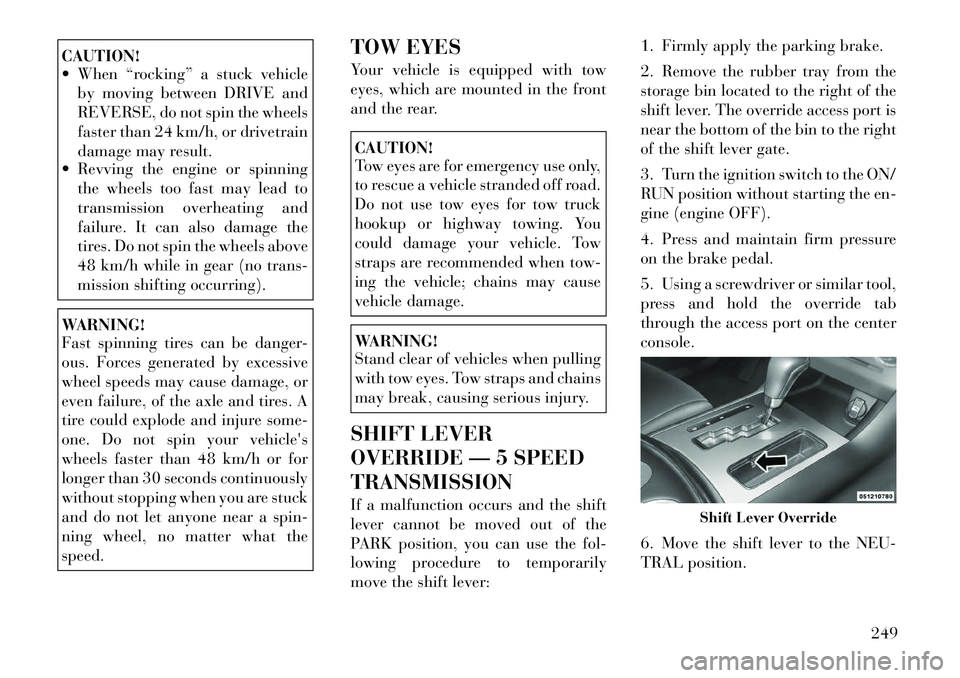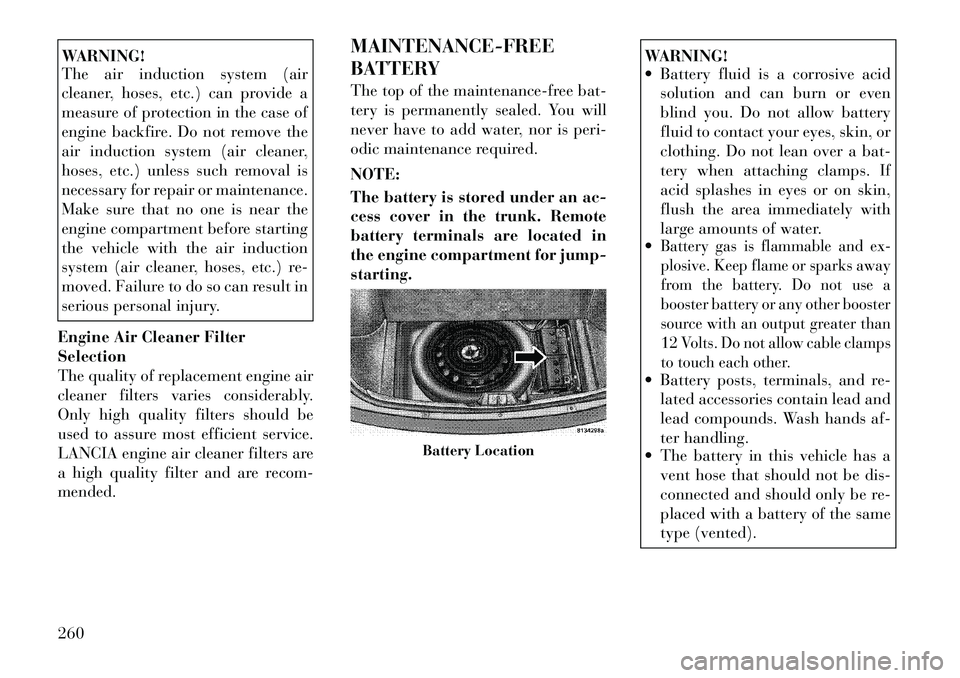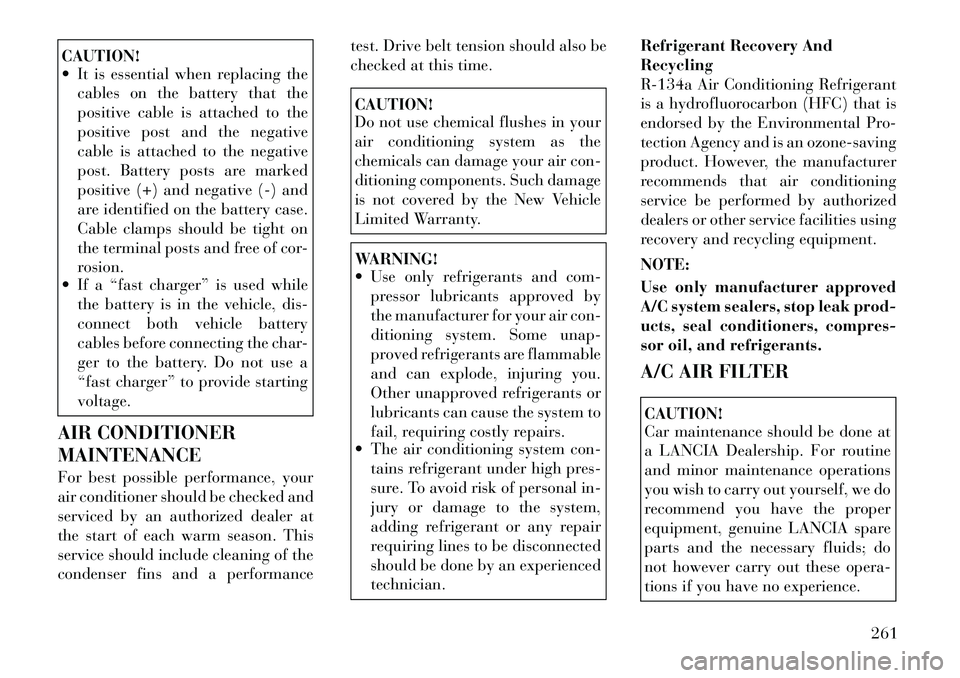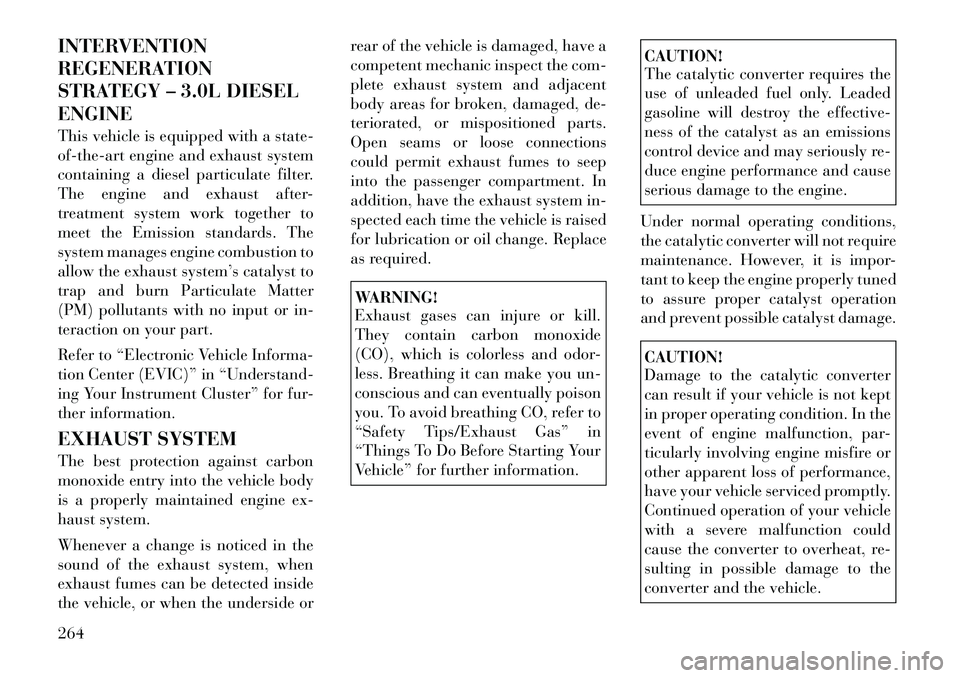warning Lancia Thema 2012 Owner handbook (in English)
[x] Cancel search | Manufacturer: LANCIA, Model Year: 2012, Model line: Thema, Model: Lancia Thema 2012Pages: 316, PDF Size: 3.85 MB
Page 255 of 316

CAUTION!
When “rocking” a stuck vehicleby moving between DRIVE and
REVERSE, do not spin the wheels
faster than 24 km/h, or drivetrain
damage may result.
Revving the engine or spinning
the wheels too fast may lead to
transmission overheating and
failure. It can also damage the
tires. Do not spin the wheels above
48 km/h while in gear (no trans-
mission shifting occurring).WARNING!
Fast spinning tires can be danger-
ous. Forces generated by excessive
wheel speeds may cause damage, or
even failure, of the axle and tires. A
tire could explode and injure some-
one. Do not spin your vehicle's
wheels faster than 48 km/h or for
longer than 30 seconds continuously
without stopping when you are stuck
and do not let anyone near a spin-
ning wheel, no matter what the
speed. TOW EYES
Your vehicle is equipped with tow
eyes, which are mounted in the front
and the rear.
CAUTION!
Tow eyes are for emergency use only,
to rescue a vehicle stranded off road.
Do not use tow eyes for tow truck
hookup or highway towing. You
could damage your vehicle. Tow
straps are recommended when tow-
ing the vehicle; chains may cause
vehicle damage.WARNING!
Stand clear of vehicles when pulling
with tow eyes. Tow straps and chains
may break, causing serious injury.
SHIFT LEVER
OVERRIDE — 5 SPEED
TRANSMISSION
If a malfunction occurs and the shift
lever cannot be moved out of the
PARK position, you can use the fol-
lowing procedure to temporarily
move the shift lever: 1. Firmly apply the parking brake.
2. Remove the rubber tray from the
storage bin located to the right of the
shift lever. The override access port is
near the bottom of the bin to the right
of the shift lever gate.
3. Turn the ignition switch to the ON/
RUN position without starting the en-
gine (engine OFF).
4. Press and maintain firm pressure
on the brake pedal.
5. Using a screwdriver or similar tool,
press and hold the override tab
through the access port on the center
console.
6. Move the shift lever to the NEU-
TRAL position.
Shift Lever Override
249
Page 256 of 316

7. The vehicle may then be started in
NEUTRAL.
8. Reinstall the rubber tray in the
storage bin.
MANUAL PARK
RELEASE — 8 SPEED
TRANSMISSION (3.6L
Engine)WARNING!
Always secure your vehicle by fully
applying the parking brake, before
activating the Manual Park Release.
Activating the Manual Park Release
will allow your vehicle to roll away if
it is not secured by the parking
brake or by proper connection to a
tow vehicle. Activating the Manual
Park Release on an unsecured ve-
hicle could lead to serious injury or
death for those in or around the ve-
hicle.
In order to push or tow the vehicle in
cases where the transmission will not
shift out of PARK (such as a dead
battery), a Manual Park Release is
available. Follow these steps to use the Manual
Park Release:
NOTE:
To prevent the vehicle from rolling
unintentionally, firmly apply the
parking brake.
1. Remove the console storage bin to
access the Manual Park Release lever.
2. Using a small screwdriver or simi-
lar tool, fish the tether strap up
through the opening in the console
base.
3. Insert the screwdriver into the slot
in the center of the lever, and disen-
gage the spring steel lever locking tab
by pushing it to the right.
4. While holding the locking tab in
the disengaged position, pull the
tether strap to rotate the lever up and
rearward, until it locks in place in the
vertical position. The vehicle is now
out of PARK and can be towed. Re-
lease the parking brake only when the
vehicle is securely connected to a tow
vehicle.
Console Storage Bin
Locking TabTether Strap
250
Page 266 of 316

WARNING!
The air induction system (air
cleaner, hoses, etc.) can provide a
measure of protection in the case of
engine backfire. Do not remove the
air induction system (air cleaner,
hoses, etc.) unless such removal is
necessary for repair or maintenance.
Make sure that no one is near the
engine compartment before starting
the vehicle with the air induction
system (air cleaner, hoses, etc.) re-
moved. Failure to do so can result in
serious personal injury.
Engine Air Cleaner Filter
Selection
The quality of replacement engine air
cleaner filters varies considerably.
Only high quality filters should be
used to assure most efficient service.
LANCIA engine air cleaner filters are
a high quality filter and are recom-
mended. MAINTENANCE-FREE
BATTERY
The top of the maintenance-free bat-
tery is permanently sealed. You will
never have to add water, nor is peri-
odic maintenance required.
NOTE:
The battery is stored under an ac-
cess cover in the trunk. Remote
battery terminals are located in
the engine compartment for jump-
starting.
WARNING!
Battery fluid is a corrosive acid
solution and can burn or even
blind you. Do not allow battery
fluid to contact your eyes, skin, or
clothing. Do not lean over a bat-
tery when attaching clamps. If
acid splashes in eyes or on skin,
flush the area immediately with
large amounts of water.
Battery gas is flammable and ex-
plosive. Keep flame or sparks away
from the battery. Do not use a
booster battery or any other booster
source with an output greater than
12 Volts. Do not allow cable clamps
to touch each other. Battery posts, terminals, and re-
lated accessories contain lead and
lead compounds. Wash hands af-
ter handling.
The battery in this vehicle has a
vent hose that should not be dis-
connected and should only be re-
placed with a battery of the same
type (vented).
Battery Location
260
Page 267 of 316

CAUTION!
It is essential when replacing thecables on the battery that the
positive cable is attached to the
positive post and the negative
cable is attached to the negative
post. Battery posts are marked
positive (+) and negative (-) and
are identified on the battery case.
Cable clamps should be tight on
the terminal posts and free of cor-
rosion.
If a “fast charger” is used while
the battery is in the vehicle, dis-
connect both vehicle battery
cables before connecting the char-
ger to the battery. Do not use a
“fast charger” to provide starting
voltage.
AIR CONDITIONER
MAINTENANCE
For best possible performance, your
air conditioner should be checked and
serviced by an authorized dealer at
the start of each warm season. This
service should include cleaning of the
condenser fins and a performance test. Drive belt tension should also be
checked at this time.
CAUTION!
Do not use chemical flushes in your
air conditioning system as the
chemicals can damage your air con-
ditioning components. Such damage
is not covered by the New Vehicle
Limited Warranty.WARNING!
Use only refrigerants and com-
pressor lubricants approved by
the manufacturer for your air con-
ditioning system. Some unap-
proved refrigerants are flammable
and can explode, injuring you.
Other unapproved refrigerants or
lubricants can cause the system to
fail, requiring costly repairs.
The air conditioning system con-
tains refrigerant under high pres-
sure. To avoid risk of personal in-
jury or damage to the system,
adding refrigerant or any repair
requiring lines to be disconnected
should be done by an experienced
technician. Refrigerant Recovery And
Recycling
R-134a Air Conditioning Refrigerant
is a hydrofluorocarbon (HFC) that is
endorsed by the Environmental Pro-
tection Agency and is an ozone-saving
product. However, the manufacturer
recommends that air conditioning
service be performed by authorized
dealers or other service facilities using
recovery and recycling equipment.
NOTE:
Use only manufacturer approved
A/C system sealers, stop leak prod-
ucts, seal conditioners, compres-
sor oil, and refrigerants.
A/C AIR FILTER
CAUTION!
Car maintenance should be done at
a LANCIA Dealership. For routine
and minor maintenance operations
you wish to carry out yourself, we do
recommend you have the proper
equipment, genuine LANCIA spare
parts and the necessary fluids; do
not however carry out these opera-
tions if you have no experience.
261
Page 269 of 316

WINDSHIELD WIPER
BLADES
Clean the rubber edges of the wiper
blades and the windshield periodi-
cally with a sponge or soft cloth and a
mild nonabrasive cleaner. This will
remove accumulations of salt or road
film.
Operation of the wipers on dry glass
for long periods may cause deteriora-
tion of the wiper blades. Always use
washer fluid when using the wipers to
remove salt or dirt from a dry wind-
shield.
Avoid using the wiper blades to re-
move frost or ice from the windshield.
Keep the blade rubber out of contact
with petroleum products such as en-
gine oil, gasoline, etc.
NOTE:
Life expectancy of wiper blades
varies depending on geographical
area and frequency of use. Poor
performance of blades may be
present with chattering, marks,
water lines or wet spots. If any ofthese conditions are present, clean
the wiper blades or replace as nec-
essary.
ADDING WASHER FLUID
The windshield washer and the head-
light washer (for versions/markets,
where provided) share the same fluid
reservoir. The fluid reservoir is lo-
cated in the front of the engine com-
partment. Be sure to check the fluid
level in the reservoir at regular inter-
vals. Fill the reservoir with windshield
washer solvent (not radiator anti-
freeze) and operate the system for a
few seconds to flush out the residual
water.
When refilling the washer fluid reser-
voir, apply some washer fluid to a
cloth or towel and wipe the wiper
blades clean. This will help blade per-
formance.
To prevent freeze-up of your wind-
shield washer system in cold weather,
select a solution or mixture that meets
or exceeds the temperature range of
your climate. This rating information
can be found on most washer fluid
containers.The fluid reservoir will hold nearly
4 Liters of washer fluid when the mes-
sage “Low Washer Fluid” appears in
the Electronic Vehicle Information
Center (EVIC) (for versions/markets,
where provided).
WARNING!
Commercially available windshield
washer solvents are flammable.
They could ignite and burn you.
Care must be exercised when filling
or working around the washer solu-
tion.CAUTION!
Car maintenance should be done at
a LANCIA Dealership. For routine
and minor maintenance operations
you wish to carry out yourself, we do
recommend you have the proper
equipment, genuine LANCIA spare
parts and the necessary fluids; do
not however carry out these opera-
tions if you have no experience.
263
Page 270 of 316

INTERVENTION
REGENERATION
STRATEGY – 3.0L DIESEL
ENGINE
This vehicle is equipped with a state-
of-the-art engine and exhaust system
containing a diesel particulate filter.
The engine and exhaust after-
treatment system work together to
meet the Emission standards. The
system manages engine combustion to
allow the exhaust system’s catalyst to
trap and burn Particulate Matter
(PM) pollutants with no input or in-
teraction on your part.
Refer to “Electronic Vehicle Informa-
tion Center (EVIC)” in “Understand-
ing Your Instrument Cluster” for fur-
ther information.
EXHAUST SYSTEM
The best protection against carbon
monoxide entry into the vehicle body
is a properly maintained engine ex-
haust system.
Whenever a change is noticed in the
sound of the exhaust system, when
exhaust fumes can be detected inside
the vehicle, or when the underside orrear of the vehicle is damaged, have a
competent mechanic inspect the com-
plete exhaust system and adjacent
body areas for broken, damaged, de-
teriorated, or mispositioned parts.
Open seams or loose connections
could permit exhaust fumes to seep
into the passenger compartment. In
addition, have the exhaust system in-
spected each time the vehicle is raised
for lubrication or oil change. Replace
as required.
WARNING!
Exhaust gases can injure or kill.
They contain carbon monoxide
(CO), which is colorless and odor-
less. Breathing it can make you un-
conscious and can eventually poison
you. To avoid breathing CO, refer to
“Safety Tips/Exhaust Gas” in
“Things To Do Before Starting Your
Vehicle” for further information.
CAUTION!
The catalytic converter requires the
use of unleaded fuel only. Leaded
gasoline will destroy the effective-
ness of the catalyst as an emissions
control device and may seriously re-
duce engine performance and cause
serious damage to the engine.
Under normal operating conditions,
the catalytic converter will not require
maintenance. However, it is impor-
tant to keep the engine properly tuned
to assure proper catalyst operation
and prevent possible catalyst damage.CAUTION!
Damage to the catalytic converter
can result if your vehicle is not kept
in proper operating condition. In the
event of engine malfunction, par-
ticularly involving engine misfire or
other apparent loss of performance,
have your vehicle serviced promptly.
Continued operation of your vehicle
with a severe malfunction could
cause the converter to overheat, re-
sulting in possible damage to the
converter and the vehicle.
264
Page 271 of 316

NOTE:
Intentional tampering with emis-
sions control systems can result in
civil penalties being assessed
against you.WARNING!
A hot exhaust system can start a fire
if you park over materials that can
burn. Such materials might be grass
or leaves coming into contact with
your exhaust system. Do not park or
operate your vehicle in areas where
your exhaust system can contact
anything that can burn.
In unusual situations involving
grossly malfunctioning engine opera-
tion, a scorching odor may indicate
severe and abnormal catalyst over-
heating. If this should occur, safely
bring the vehicle to a complete stop,
shut the engine OFF, and allow the
vehicle to cool. Thereafter, obtain ser-
vice, including a tune-up to manufac-
tur er's specifications immediately.
To minimize the possibility of catalyst
damage: Do not shut off the engine or inter
-
rupt the ignition when the trans-
mission is in gear and the vehicle is
in motion.
Do not try to start the engine by pushing or towing the vehicle.
Do not idle the engine with any spark plug wires disconnected or
removed, such as when diagnostic
testing, or for prolonged periods
during very rough idling or mal-
functioning operating conditions.
COOLING SYSTEM
WARNING!
When working near the radiator cooling fan, disconnect the fan
motor lead or turn the ignition
switch to the LOCK position . The
fan is temperature controlled and
can start at any time the ignition
switch is in the ON position.
(Continued)
WARNING!(Continued)
You or others can be badly burned
by hot engine coolant (antifreeze)
or steam from your radiator. If
you see or hear steam coming
from under the hood, do not open
the hood until the radiator has
had time to cool. Never try to open
a cooling system pressure cap
when the radiator is hot.CAUTION!
Car maintenance should be done at
a LANCIA Dealership. For routine
and minor maintenance operations
you wish to carry out yourself, we do
recommend you have the proper
equipment, genuine LANCIA spare
parts and the necessary fluids; do
not however carry out these opera-
tions if you have no experience.
Coolant Checks
Check engine coolant (antifreeze)
protection every 12 months (before
the onset of freezing weather, where
applicable). If the engine coolant (an-
tifreeze) is dirty or rusty in appear-
ance, the system should be drained,
265
Page 273 of 316

When adding engine coolant (anti-
freeze):
Use only high purity water such as
distilled or deionized water when
mixing the water/engine coolant (an-
tifreeze) solution. The use of lower
quality water will reduce the amount
of corrosion protection in the engine
cooling system.
Please note that it is theowner's re-
sponsibility to maintain the proper
level of protection against freezing ac-
cording to the temperatures occurring
in the area where the vehicle is oper-
ated.
NOTE:
Mixing engine coolant (antifreeze)
types will decrease the life of the
engine coolant (antifreeze) and
will require more frequent engine
coolant (antifreeze) changes.
Cooling System Pressure Cap
The cap must be fully tightened to
prevent loss of engine coolant (anti-
freeze), and to ensure that engine
coolant (antifreeze) will return to the
radiator from the coolant recovery
bottle. The cap should be inspected and
cleaned if there is any accumulation
of foreign material on the sealing sur-
faces.
WARNING!
The warning words “DO NOT
OPEN HOT” on the cooling sys-
tem pressure cap are a safety pre-
caution. Never add engine coolant
(antifreeze) when the engine is
overheated. Do not loosen or re-
move the cap to cool an over-
heated engine. Heat causes pres-
sure to build up in the cooling
system. To prevent scalding or in-
jury, do not remove the pressure
cap while the system is hot or un-
der pressure.
Do not use a pressure cap other
than the one specified for your
vehicle. Personal injury or engine
damage may result.
Disposal Of Used Coolant
Used ethylene glycol-based engine
coolant (antifreeze) is a regulated
substance requiring proper disposal.
Check with your local authorities to
determine the disposal rules for your community. To prevent ingestion by
animals or children, do not store eth-
ylene glycol-based engine coolant
(antifreeze) in open containers or al-
low it to remain in puddles on the
ground. If ingested by a child or pet,
seek emergency assistance immedi-
ately. Clean up any ground spills im-
mediately.
Coolant Level
The coolant bottle provides a quick
visual method for determining that
the coolant level is adequate. With the
engine OFF and cold, the level of the
coolant in the bottle should be be-
tween the ranges indicated on the
bottle.
The radiator normally remains com-
pletely full, so there is no need to
remove the radiator cap unless check-
ing for engine coolant (antifreeze)
freeze point or replacing engine cool-
ant (antifreeze). Advise your service
attendant of this. As long as the en-
gine operating temperature is satis-
factory, the coolant bottle need only
be checked once a month.
267
Page 274 of 316

When additional engine coolant (an-
tifreeze) is needed to maintain the
proper level, it should be added to the
coolant bottle. Do not overfill.
Points To Remember
NOTE:
When the vehicle is stopped after a
few kilometers of operation, you
may observe vapor coming from
the front of the engine compart-
ment. This is normally a result of
moisture from rain, or high hu-
midity accumulating on the radia-
tor and being vaporized when the
thermostat opens, allowing hot en-
gine coolant (antifreeze) to enter
the radiator.
If an examination of your engine com-
partment shows no evidence of radia-
tor or hose leaks, the vehicle may be
safely driven. The vapor will soon dis-
sipate.
Do not overfill the coolant recoverybottle.
Check engine coolant (antifreeze) freeze point in the radiator and in
the coolant recovery bottle. If en-
gine coolant (antifreeze) needs to be added, contents of coolant re-
covery bottle must also be pro-
tected against freezing.
If frequent engine coolant (anti- freeze) additions are required, or if
the level in the coolant recovery
bottle does not drop when the en-
gine cools, the cooling system
should be pressure tested for leaks.
Maintain engine coolant (anti- freeze) concentration at 50% en-
gine coolant (antifreeze) (mini-
mum) and distilled water for
proper corrosion protection of your
engine, which contains aluminum
components.
Make sure that the radiator and coolant recovery bottle overflow
hoses are not kinked or obstructed.
Keep the front of the radiator clean. If your vehicle is equipped with air
conditioning, keep the front of the
condenser clean.
Do not change the thermostat for Summer or Winter operation. If re-
placement is ever necessary, install
ONLY the correct type thermostat.
Other designs may result in unsat- isfactory engine coolant (anti-
freeze) performance, poor gas mile-
age, and increased emissions.
BRAKE SYSTEM
In order to assure brake system per-
formance, all brake system compo-
nents should be inspected periodi-
cally. Refer to the “Maintenance
Schedule” for the proper maintenance
intervals.
WARNING!
Riding the brakes can lead to brake
failure and possibly an accident.
Driving with your foot resting or rid-
ing on the brake pedal can result in
abnormally high brake tempera-
tures, excessive lining wear, and pos-
sible brake damage. You would not
have your full braking capacity in an
emergency.
268
Page 275 of 316

CAUTION!
Car maintenance should be done at
a LANCIA Dealership. For routine
and minor maintenance operations
you wish to carry out yourself, we do
recommend you have the proper
equipment, genuine LANCIA spare
parts and the necessary fluids; do
not however carry out these opera-
tions if you have no experience.
Master Cylinder – Brake Fluid
Level Check
Check the fluid level in the master
cylinder immediately if the brake sys-
tem warning light indicates system
failure.
Check the fluid level in the master
cylinder when performing underhood
services.
Clean the top of the master cylinder
area before removing the cap. Add
fluid to bring the level up to the
“MAX” mark on the side of the master
cylinder reservoir.
Add enough fluid to bring the level up
to the requirements described on the
brake fluid reservoir. With disc brakes, fluid level can be expected to
fall as the brake pads wear. However,
low fluid level may be caused by a
leak and a checkup may be needed.
Use only manufactur
er's recom-
mended brake fluid. Refer to “Fluids,
Lubricants, and Genuine Parts” in
“Maintaining Your Vehicle” for fur-
ther information.
WARNING!
Use only manufactur er's recom-
mended brake fluid. Refer to
“Fluids, Lubricants, and Genuine
Parts” in “Maintaining Your Ve-
hicle” for further information. Us-
ing the wrong type of brake fluid
can severely damage your brake
system and/or impair its perfor-
mance. The proper type of brake
fluid for your vehicle is also iden-
tified on the original factory in-
stalled hydraulic master cylinder
reservoir.
(Continued)
WARNING!(Continued)
To avoid contamination from for-
eign matter or moisture, use only
new brake fluid or fluid that has
been in a tightly closed container.
Keep the master cylinder reservoir
cap secured at all times. Brake
fluid in a open container absorbs
moisture from the air resulting in
a lower boiling point. This may
cause it to boil unexpectedly dur-
ing hard or prolonged braking,
resulting in sudden brake failure.
This could result in a accident.
Overfilling the brake fluid reser-
voir can result in spilling brake
fluid on hot engine parts, causing
the brake fluid to catch fire. Brake
fluid can also damage painted and
vinyl surfaces, care should be
taken to avoid its contact with
these surfaces.
Do not allow petroleum based
fluid to contaminate the brake
fluid. Brake seal components
could be damaged, causing partial
or complete brake failure. This
could result in an accident.
269